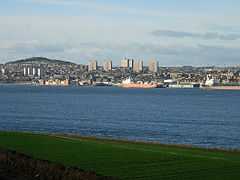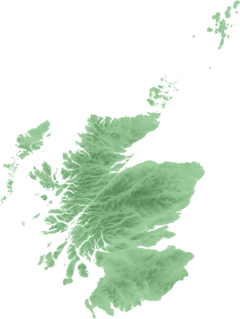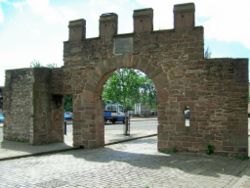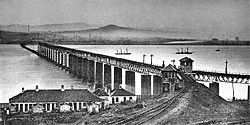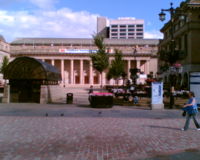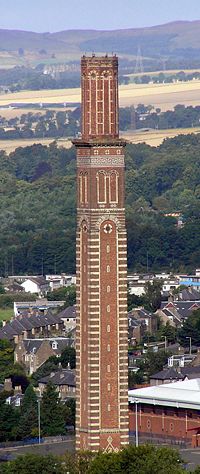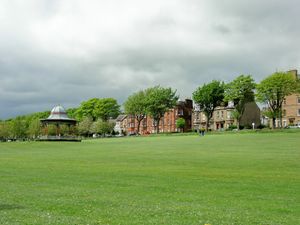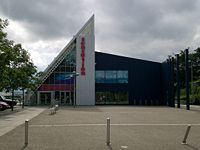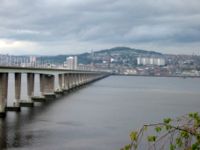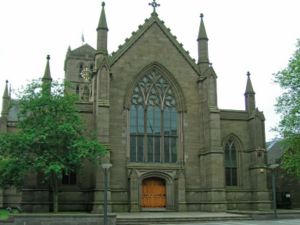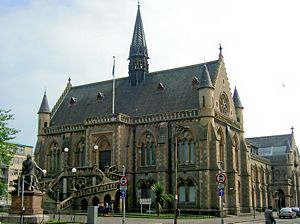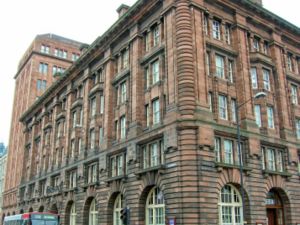Dundee
2008/9 Schools Wikipedia Selection. Related subjects: British Cities; Great Britain
| Dundee | |
| Scottish Gaelic: Dùn Dèagh | |
| Scots: Dundee | |
| City of Discovery | |
|
Dundee shown within Scotland |
|
| Area | 26 sq mi (67.3 km²) |
|---|---|
| Population | 143,090 |
| OS grid reference | |
| Council area | Dundee City |
| Lieutenancy area | Dundee |
| Constituent country | Scotland |
| Sovereign state | United Kingdom |
| Post town | DUNDEE |
| Postcode district | DD1-DD6 |
| Dialling code | 01382 |
| Police | Tayside |
| Fire | Tayside |
| Ambulance | Scottish |
| European Parliament | Scotland |
| UK Parliament | Dundee East |
| Dundee West | |
| Scottish Parliament | Dundee East |
| Dundee West | |
| Angus | |
| North East Scotland | |
| List of places: UK • Scotland | |
Coordinates:
Dundee ( Scottish Gaelic: Dùn Dèagh) is the fourth-largest city in Scotland and, fully named as Dundee City, one of Scotland's 32 local government council areas. It is on the north bank of the River Tay's estuary which feeds into the North Sea.
Dundee's history begins with the Picts in the Iron Age. During the Medieval Era, it was the site of many battles. The port developed initially on the back of the wool trade exporting wool from the Angus hinterland. Once it was cheaper to produce linen, which had supplanted the wool trade and was itself under pressure from cotton, abroad the weavers turned their skills to weaving imported jute. The weaving industry caused the city to grow rapidly with many migrant workers though the town contained very few stone buildings prior to 1860. In this period, Dundee also gained a reputation for its marmalade industry and its journalism, giving Dundee its epithet as the city of "jam, jute and journalism".
Presently, Dundee's population is 143,090. However, if contiguous settlements—such as Monifieth, Birkhill, and Invergowrie—are counted, the number is around 170,000. Dundee's population reached a peak of nearly 200,000 at the start of the 1970s, but has since declined, due to outward migration and the change of council boundaries in the 1970s and 1980s, which saw Dundee lose suburbs to the surrounding counties.
Today, Dundee is promoted as the City of Discovery, in honour of Dundee's history of scientific activities and of the RRS Discovery, Robert Falcon Scott's Antarctic exploration vessel, which was built in Dundee and is now berthed in the city harbour. If you look carefully at the advertising hoardings by the airport in the popular computer game Grand Theft Auto Vice City you will see a sign which says "Come to Dundee we have a ship which belonged to a loser". Biomedical and technological industries have arrived since the 1980s, and the city now accounts for 10% of the United Kingdom's digital-entertainment industry. Dundee has two universities—the University of Abertay Dundee and the University of Dundee. The city is home to the Scottish Dance Theatre, which is based in the city's renowned Dundee Repertory Theatre. The Royal Scottish National Orchestra regularly plays in the city's Caird Hall. On 5 March 2004 Dundee was granted Fairtrade City status.
History
The date of the earliest settlement on the present site of Dundee is unknown, but certainly long before its first mention in historical records in the 12th century. The name "Dundee", Gaelic Dùn Dèagh, incorporates the place-name element dùn, fort, possibly referring to the hill-fort, traces of which survive on Dundee Law. The meaning of Dundee is unknown, though it has been suggested it could mean 'Fort of Fire', perhaps referring to beacons lit on the Law, or 'Fort of the God'. In 1191, the town was awarded a charter making it a royal burgh, which would indicate that it was already a town of some size and importance. This charter was later revoked by Edward I, though it was replaced by a new charter from Robert the Bruce in 1327. Dundee became a walled city in 1545, owing to a period of hostilities known as the rough wooing. In July 1547, much of the city was destroyed by an English naval bombardment. In 1645, during the Wars of the Three Kingdoms, Dundee was again besieged, this time by the Royalist Marquess of Montrose. In 1651 during the Third English Civil War, it was invaded by General Monck, who was the commander of Oliver Cromwell's forces in Scotland. These English Parliamentarians destroyed much of the city and killed many of its inhabitants. Dundee was later the site of an early Jacobite uprising when John Graham, 1st Viscount Dundee raised the Stuart standard on Dundee Law in support of James VII (James II of Great Britain) following his overthrow, earning him the nickname Bonnie Dundee.
Dundee greatly expanded in size during the Industrial Revolution mainly because of the flax and then latterly the jute industry. By the end of the 19th century, a majority of the city's workers were employed in its many jute mills and in related industries. Dundee's location on a major estuary allowed for the easy importation of jute from the Indian subcontinent as well as whale oil—needed for the processing of the jute—from the city's large whaling industry. The industry began to decline in the 20th century as it became cheaper to process the cloth on the Indian subcontinent. The city's last jute mill closed in the 1970s.
In addition to jute the city is also known for jam and journalism. The "jam" association refers to marmalade, which was purportedly invented in the city by Janet Keiller in 1797 (although in reality, recipes for marmalade have been found dating back to the 1500s). Keiller's marmalade became a famous brand because of its mass production and its worldwide export. Local firm Mackays still makes marmalade in Dundee. However, the industry was never a major employer compared with the jute trade. Marmalade has since become the "preserve" of larger businesses, but jars of Keiller's marmalade are still widely available. "Journalism" refers to the publishing firm DC Thomson & Co., which was founded in the city in 1905 and remains the largest employer after the health and leisure industries. The firm publishes a variety of newspapers, children's comics and magazines, including The Sunday Post, The Courier, Shout and children's publications, The Beano and The Dandy.
Dundee also developed a major maritime and shipbuilding industry in the 19th century. 2,000 ships were built in Dundee between 1871 and 1881, including the Antarctic research ship used by Robert Falcon Scott, the RRS Discovery. This ship is now on display at Discovery Point in the city, and the Victorian steel-framed works in which Discovery's engine was built is now home to the city's largest bookstore. The need of the local jute industry for whale oil also supported a large whaling industry. Dundee Island in the Antarctic takes its name from the Dundee whaling expedition, which discovered it in 1892. Whaling ceased in 1912 and shipbuilding ceased in 1981. The estuary was the location of the first Tay rail bridge, built by Thomas Bouch and opened in 1879. At the time it was the longest railway bridge in the world. The bridge fell down in a storm less than a year later under the weight of a train full of passengers in what is known as The Tay Bridge Disaster. None of the passengers survived.
Governance
Dundee was first made a royal burgh in 1191 and became a unitary council area in 1996 under the Local Government etc. (Scotland) Act 1994, which gave it a single tier of local government control under the Dundee City Council. The city has two mottos—Dei Donum (Latin: Gift of God) and Prudentia et Candore (With Thought And Purity), although usually only the latter is used for civic purposes. Dundee is represented in both the British House of Commons and in the Scottish Parliament. For elections to the European Parliament, Dundee is within the Scotland constituency.
Local government
Dundee is one of 32 council areas of Scotland, represented by the Dundee City Council, a local authority composed of 29 elected councillors. Previously the city was a county of a city and later a district of the Tayside region. Council meetings take place in the City Chambers, which opened in 1933 and are located in City Square. The civic head and chair of the council is known as the Lord Provost, a position similar to that of mayor in other cities. The council executive is based in Tayside House on the banks of the River Tay, but the council recently announced plans to demolish it in favour of new premises (Dundee House) on North Lindsay Street.
The council was controlled by a minority coalition of Labour and Liberal Democrats of 12 councillors, with the support of the Conservatives who had five. Although the Scottish National Party (SNP) was the largest party on the council, with 11 councillors. Elections to the council are on a four year cycle, the most recent as of 2007 being on 3 May 2007. Previously, Councillors were elected from single-member wards by the first past the post system of election, although this changed in the 2007 election, due to the Local Governance (Scotland) Act 2004. Eight new multi-member wards were introduced, each electing three or four councillors by single transferable vote, to produce a form of proportional representation. The 2007 election resulting in no single party having overall control, with 13 Scottish National Party, 10 Labour, 3 Conservatives, 2 Liberal Democrats, and 1 Independent Councillors.
Westminster and Holyrood
For elections to the British House of Commons at Westminster, the city area and portions of the Angus council area are divided in two constituencies. The constituencies of Dundee East and Dundee West are as of 2007 represented by Stewart Hosie (Scottish National Party (SNP)) and James McGovern (Labour), respectively. For elections to the Scottish Parliament at Holyrood, the city area is divided between three constituencies. The Dundee East (Holyrood) constituency and the Dundee West (Holyrood) constituency are entirely within the city area. The Angus (Holyrood) constituency includes north-eastern and north-western portions of the city area. All three constituencies are within the North East Scotland electoral region. as of 2007 Shona Robison (SNP) is the Member of the Scottish Parliament (MSP) for the Dundee East constituency; Joe Fitzpatrick (SNP) is the current MSP for the Dundee West constituency and Andrew Welsh (SNP) is the current MSP for the Angus constituency.
International links
Dundee maintains cultural, economic and educational ties with six twin cities:
 – Orleans, France (1946)
– Orleans, France (1946) – Zadar, Croatia (1959)
– Zadar, Croatia (1959) – Würzburg, Germany (1962)
– Würzburg, Germany (1962) – Alexandria, Virginia, USA (1974)
– Alexandria, Virginia, USA (1974) – Nablus, West Bank (1980)
– Nablus, West Bank (1980) – Dubai, United Arab Emirates (2004)
– Dubai, United Arab Emirates (2004)
In addition, the Scottish Episcopalian Diocese of Brechin (centred on St Paul’s Cathedral in Dundee) is twinned with the diocese of Iowa, USA and the diocese of Swaziland.
Geography
Dundee is located on the north bank of the Firth of Tay and near the North Sea. The city surrounds the basalt plug of an extinct volcano, called Dundee Law or simply The Law (174 metres (571 ft)). Dundee is Scotland's only south-facing city, giving it a claim to being Scotland's sunniest and warmest city. Temperatures tend to be a couple of degrees higher than Aberdeen to the north or the coastal areas of Angus. Dundee suffers less severe winters than other parts of Scotland due to the close proximity to the North sea and the salt air and a range of protective hills at the back of the city, which are often snow covered while the city itself remains clear.
The city, being on a relatively small landspace, is the most densely populated area in Scotland after Glasgow and around fifth in the UK overall. It is characterised by tall tenements, mainly four storeys high, Victorian, and built from a honey or brown sandstone. The centre is a mishmash of redevelopment and neglect with shopping malls and the usual national retailers. The inner districts of the city, as well as some of the outer estates, are home to a large number of multi storey tower blocks from the 1960s. The outer estates are among some of the poorest urban districts in the United Kingdom. To the east of the city area is the distinct but incorporated suburb of Broughty Ferry with its yacht club, wide ranging and upmarket services and expensive houses—many of architectural note, developed during the Industrial Revolution, housing professionals, footballers, and the GMTV presenter Lorraine Kelly. A recent apartment in Broughty Ferry entered the market with an asking price of £750,000, far higher than the Scottish average.
Dundee lies close to Perth (20 miles) and the southern Highlands to the west. St Andrews (14 miles) and north-east Fife are situated to the south, while the Sidlaw Hills, Angus Glens and the Glamis Castle are located to the north. Two of Scotland's most prestigious links golf courses, St Andrews and Carnoustie are located nearby. The towns of Invergowrie in Perthshire, Newport on Tay in Fife and Monifieth and Birkhill in Angus are outside of local government control of Dundee but are de facto suburbs of the city.
Demography
Natives of Dundee are called Dundonians and are recognisable by their distinct accent, which most noticeably substitutes the monophthong /e/ in place of the diphthong /ai/. A significant proportion of the population are on a lower than average income or receive social security benefits. More than half of the city's council wards are among Scotland's most deprived and fewer than half of the homes in Dundee are owner-occupied, a slight majority being owned by housing associations and the council, although it does rank higher than Glasgow. For all its social problems, neither do Dundonians die as early as Glaswegians. The Whitfield area in particular has the highest rate of child poverty in the UK at 96%. Dundee had the highest rate of abortions in Scotland in 2004 (24.2 per 1000) and the highest rate of teenage pregnancy in Western Europe. (1 in 16; the national average is 1 in 23).
Dundee's population increased substantially with the urbanisation of the Industrial Revolution as did other British cities. The most significant influx occurred in the mid-1800s with the arrival of Irish workers fleeing from the Potato Famine and attracted by industrialisation. Today Dundee has 5,000 Northern Irish born residents in its boundary mostly due to universities and there is a large Northern Irish club which is based at Dundee Union The city also attracted immigrants from Italy, fleeing poverty and famine, and Poland, seeking refuge from the anti-Jewish pogroms in the 19th century, and later, World War II in the 20th. Today, Dundee has a sizeable ethnic minority population, and has the third highest Asian population (~3,500) in Scotland after Glasgow and Edinburgh. Dundee has attracted large numbers of Eastern Europeans and is predicted to expand further due to Bulgarian immigrants. Abertay University and Dundee University draw a large number of students from abroad (mostly Irish and EU but with an increasing number from countries in the Far East), and students account for 14.2% of the population, the highest proportion of the four largest Scottish cities. Dundee is also one of only four local authorities in Scotland to recycle more than 20% of its waste.
Economy
Dundee is a regional employment and education centre, with over 300,000 persons within 30 minutes drive of the city centre and 700,000 people within one hour. Many people from North East Fife, Angus and Perth and Kinross commute to the city. In 2006 the city itself had an economically active population of 76.7% of the working age population, about 20% of the working age population are full time students. The city sustains just under 95,000 jobs in around 4,000 companies. The number of jobs in the city has grown by around 10% since 1996. Recent and current investment levels in the city are at a record level. Since 1997 Dundee has been the focus of investment approaching an estimated £1 billion.
Despite this economic growth the proportion of Dundee’s population whose lives are affected by poverty and who are classed as socially excluded is second only to Glasgow. Median weekly earnings were £409 in February 2006, an increase of 33% since 1998, on a par with the Scottish median. Unemployment in 2006 was around 3.8%, higher than the Scottish average of 2.6%, although the city has “closed the gap” since 1996 when unemployment was 8.6% with the Scottish average at 6.1%. In 2000 the number of unemployed in the city had fallen to below 5,000 for the first time in over 25 years. Average house prices in Dundee have more than doubled since 1990 from an average of £42,475, to £102,025 in 2006. Total house sales in the city have more than tripled since 1990 from £115,915,391 to £376,999,716 in 2004. House prices rose by over 15% between 2001–2002 and 2002–2003 and between 2005 and 2006 by 16.6%.
Modern Economic History
The period following World War II was notable for the transformation of the city's economy. While jute still employed one-fifth of the working population, new industries were attracted and encouraged. NCR Corporation selected Dundee as the base of operations for the UK in late 1945, primarily because of the lack of damage the city had sustained in the war, good transport links and high productivity from long hours of sunshine. Production started in the year before the official opening of the plant on June 11, 1947. A fortnight after the 10th anniversary of the plant, the 250,000th cash machine was produced. By the 1960s, NCR had become the principal employer of the city producing cash registers, and later ATMs, at several of its Dundee plants. The firm, developed magnetic-strip readers for cash registers and produced early computers. Astral, a Dundee-based firm that manufactured and sold refrigerators and spin dryers was merged into Morphy Richards and rapidly expanded to employ over 1,000 people. The development in Dundee of a Michelin tyre-production facility helped to absorb the unemployment caused by the decline of the jute industry, particularly with the abolition of the jute control by the Board of Trade on April 30, 1969.
Employment in Dundee changed dramatically during the 1980s with the loss of nearly 10,000 manufacturing jobs due to closure of the shipyards, cessation of carpet manufacturing and the disappearance of the jute trade. To combat growing unemployment and declining economic conditions, Dundee was declared an Enterprise Zone in January 1984. In 1983, the first Sinclair ZX Spectrum home computers were produced in Dundee by Timex. In the same year the company broke production records, despite a sit-in by workers protesting job cuts and plans to demolish one of the factory buildings to make way for a supermarket. Timex closed its Dundee plant in 1993 following an acrimonious six month industrial dispute. In January 2007, NCR announced its intention to cut 650 jobs at its Gourdie facility, and to turn the facility over for low volume production. The company has pledged to retain R&D, software, sales and support functions in Dundee.
Modern day
As in the rest of Scotland manufacturing industries are being gradually replaced by a mixed economy, although 13.5% of the workforce still work in the manufacturing sector, higher than the Scottish and UK average, and more than double that of Edinburgh, Glasgow and Aberdeen. The main new growth sectors have been software development and biotechnology along with retail. The city has a small financial, banking and insurance sector, employing 11% of the workforce.
In 2006, 29 companies employed 300 or more staff these include limited and private companies NCR Corporation, Michelin, Tesco, D. C. Thomson & Co, BT, SiTEL, Norwich Union, Royal Bank of Scotland, ASDA, Strathtay Scottish, Tayside Contracts, Tokheim, Scottish Citylink, W H Brown Construction, C J Lang & Son, Joinery and Timber Creations, HBOS, Debenhams, Travel Dundee, WL Gore and Associates, In Practice Systems, The Wood Group, Simclar, Millipore Life Sciences, Alchemy (antibody technology), Cypex(manufacturers of recombinant drug metabolising enzymes, including cytochrome P450s, and in vitro drug metabolism specialists). Major employers in the public sector and non profit sector are NHS Tayside, the University of Dundee, Tayside Police, Dundee College, Tayside Fire Brigade, HM Revenue and Customs, University of Abertay Dundee and Wellcome Trust.
The largest employers in Dundee are the city council and the National Health Service, which make up over 10% of the city's workforce. The biomedical and biotechnology sectors, including start-up biomedical companies arising from university research, employ just under 1,000 people directly and nearly 2,000 indirectly. Information technology and software for computer games have been important industries in the city for more than twenty years. Rockstar North, developer of Lemmings and the Grand Theft Auto series was founded in Dundee as DMA Design by David Jones; an undergraduate of the University of Abertay Dundee. David Jones is now the CEO of Realtime Worlds, which has recently (2007) released Crackdown for the Xbox 360, and is responsible for employing over 200 people of multi national origin, primarily in Dundee.
Dundee is responsible for 10% of Britain’s digital entertainment industry, with an annual turnover of £100 million. Outside of specialised fields of medicine, science and technology, the proportion of Dundonians employed in the manufacturing sector is higher than that found in the larger Scottish cities; nearly 12% of workers. Manufacturing income per head in Dundee was £19,700 in 1999, compared to £16,700 in Glasgow. The insolvency rate for businesses in Dundee is lower than other Scottish cities, accounting for only 2.3% of all liquidations in Scotland, compared to 22% and 61.4% for Edinburgh and Glasgow respectively.
The surrounding area is home to three major UK military bases, Condor (Royal Marines), Leuchars (RAF) which can cause sudden noise from aircraft exercises, and Barry (army and training).
The city is served by Ninewells Hospital—one of the largest and most up to date in Europe, as well as three other public hospitals: Kings Cross, Victoria, and Ashludie, and one private: Fernbrae.
Transport
Dundee is served by the A90 road which connects the city to the M90 and Perth in the west, and Forfar and Aberdeen in the north. The part of the road that is in the city is a dual carriageway and forms the city's main bypass on its north side, known as the Kingsway, which can become very busy at rush hour. To the east, the A92 connects the city to Monifieth and Arbroath. The A92 also connects the city to the county of Fife on the south side of the Tay estuary via the Tay Road Bridge. The main southern route around the city is Riverside Drive and Riverside Avenue (the A991), that runs alongside the Tay from a junction with the A90 in the west, to the city centre where it joins the A92 at the bridge.
Dundee has an extensive public bus transport system, with the Seagate Bus Station serving as the city's main terminus for journeys out of town. Travel Dundee operates most of the intra-city services, with other more rural services operated by Stagecoach Strathtay. The city's two railway stations are the main Dundee (Tay Bridge) Station, which is situated near the waterfront and the much smaller Broughty Ferry Station, which is located to the eastern end of the city. These are complemented by the stations at Invergowrie railway station, Balmossie and Monifieth railway station. Passenger services at Dundee are provided by First ScotRail, CrossCountry and NXEC. There are no freight services that serve the city since the Freightliner terminal in Dundee was closed in the 1980s.
Dundee Airport offers commercial flights to London City Airport, Birmingham International Airport and Belfast City. The airport is capable of serving small aircraft and is located 3 kilometres west of the city centre, adjacent to the Tay river. The nearest major international airport is Edinburgh Airport, 59.2 miles (95.3 km) to the south.
The nearest passenger seaport is Rosyth, about 35 miles (56 km) to the south on the Firth of Forth.
Education
Schools
Schools in Dundee have a pupil enrollment of over 20,300. There are forty-one primary schools and ten secondary schools in the city. Of these, twelve primary and three secondary schools serve the city's Roman Catholic population; the remainder are non-denominational. Until 2005 Dundee was home to the independent Muhammad Zakariya School for girls of Muslim parents—the only one of its kind in Scotland. The school received poor inspection reports and closed in the 2005-2006 academic year. Standards in Dundee's primary schools have shown continuous improvement since 2001, with most meeting or exceeding the national average for rates of improvement. Educational performance at standard and higher grade in secondary schools had been well below the national average in 1997 to 1999, although subsequent figures have shown a significant improvement. Between 2003 to 2005, 85% of pupils achieved access 3 or standard grade, 5–6 in English or Maths and 12% achieving at least 5 higher awards at A–C grades. The average number of graduates who continued on to further or higher education was 56% in the school year 2004/5, 4% higher than the national average of 52%. This was an increase from the period of 1997 to 1999 when the rate had been well below the national average. The rate of truancy in Dundee schools has improved to 0.2% from previous rates, which had exceeded the national average of 0.8%.
Dundee is home to one independent school, the High School of Dundee, which was founded in the 13th century by the Abbot and monks of Lindores. Early students included William Wallace (allegedly), Hector Boece and the brothers James, John and Robert Wedderburn who were the authors of The Gude and Godlie Ballatis, one of the most important literary works of the Scottish Reformation. It was the earliest reformed school in Scotland, having adopted the new religion in 1554.
The most prominent of Dundee's state secondary schools are the 4 former academies (all of which still bear the title): Harris Academy, Morgan Academy, Grove Academy and Lawside Academy. Harris Academy was founded in 1885 and is the largest state school in the city. Former pupils include MP George Galloway, professional footballer Christian Dailly and the former vice-chairman of Rangers Football Club, Donald Findlay. Morgan Academy dates back to 1888 when the Dundee Burgh School Board bought Morgan hospital and reopened it as a school. The school and the prior hospital take their names from John Morgan, who bequeathed much of his fortune to establish a residential institution. The building was gutted by fire in 2001 but has since been restored and updated. Grove Academy traditionally educated the children from the Broughty Ferry area of Dundee, where wealthy 19th century merchants built their villas. It was named as one of the top 50 Scottish schools in the 2004-2005 academic year. Lawside Academy was established by the Sisters of Mercy in 1907 and, before the introduction of comprehensive schooling in the 1970s, served as the only Catholic academy for many miles, with students travelling from Perth, Arbroath, Forfar and Cupar. Although Catholic, the school welcomes people from all faiths, and at any one time some 20% of the student body is non-Catholic. In 2003, Dundee City Council decided to merge Lawside with St. Saviour's RC High; this will take effect with the 2008-2009 academic year, one year after Lawside celebrates its centenary. The name of the new school will be St.Paul's Academy.
Colleges and universities
Dundee is home to two universities and a student population of approximately 17,000. The University of Dundee became an independent entity in 1967, after 70 years of being incorporated into the University of St Andrews during which time it was known as Queen's College. Significant research in biomedical fields and oncology is carried out in the "College of Life Sciences". The university also incorporates the Duncan of Jordanstone School of Art and Design. In October 2005, the university became the first UNESCO centre in the UK; the centre will be involved in research regarding the management of the world's water resources on behalf of the United Nations. The University of Dundee was ranked third for social work, seventh for architecture and eighth for biological sciences. It was voted Scottish University of the Year by the Sunday Times 2006
The University of Abertay Dundee is a new university; created in 1994 under legislation granting the status of university to the Dundee Institute of Technology, which had been founded in 1888. The university has a computer games technology and design department that holds an annual computer game production competition called Dare to Be Digital. The university is also home to the Dundee Business School. In May 2002, University of Abertay Dundee was ranked number one in the United Kingdom for its investment in IT facilities by the Financial Times.
Dundee College is the city's umbrella further education college, which was established in 1985 as an institution of higher education and vocational training. The college is noted for its New Media centre and incorporates the Scottish School of Contemporary Dance. In a 2005 HMIE inspection, the college's teaching and learning process were rated "very good" in six of the seven subject areas and overall evaluations.
Religious sites
The City Churches, Dundee Parish Church (St Mary's) and the Steeple Church, are the most prominent Church of Scotland buildings in Dundee. They are on the site of the medieval parish kirk of St Mary, of which only the 15th century west tower survives. The attached church was once the largest parish church in medieval Scotland. Dundee was unusual among Scottish medieval burghs in having two parish kirks; the second, dedicated to St Clement, has disappeared, but its site was approximately that of the present City Square. In the Middle Ages Dundee was also the site of houses of the Dominicans (Blackfriars), and Franciscans (Greyfriars), and had a number of hospitals and chapels. These establishments were sacked during the Reformation in the 16th century and have been reduced to sites.
The Church of Scotland Presbytery of Dundee currently consists of 45 congregations although, due to dwindling numbers, many now share a minister. Robert Murray McCheyne, who was the minister of St Peter's (now Free Church of Scotland) from 1838 until his death in 1843, led a significant religious revival in Dundee. There are two cathedrals in the city: St. Paul's (Scottish Episcopal) and St. Andrew's (Roman Catholic).
The Catholic community is part of the Diocese of Dunkeld which is led by Bishop Vincent Paul Logan. The fact that 3 of the city's 10 secondary schools are Roman Catholic attests to a sizable Catholic community, an unusual occurrence in the East of Scotland. By way of comparison, Edinburgh (almost 3 times the size of Dundee) also has 3 Catholic secondary schools and Aberdeen has none. There are 19 Catholic parishes (including two university chaplaincies) within the boundaries of Dundee City. A recent influx of people from Poland has led to the Pallotines establishing a presence in the community, and they have taken up residence in the parish dedicated to Saint Francis of Assisi.
Muslims are served by a large mosque, several secondary mosques and the Al Maktoum Institute of Islamic and Arabic Studies which opened in 2000. Scotland's only private Islamic school for girls, the 'Imam Muhammed Zakariya School for Islamic Studies' is located in Broughty Ferry. Halal stores and restaurants, along with specialist shops selling Asian clothes and accessories can be found in and around the Hilltown area.
A recorded Jewish community has existed in the city since the 19th century. The present orthodox synagogue at Dudhope Park was built in the 1970s, with the Hebrew Burial Grounds located around three miles (5 km) to the east. There is also a Hindu mandir and Sikh gurdwara located in the city.
Culture
Dundee is home to Scotland's only full-time repertory ensemble, established in the 1930s. One of its alumni, Hollywood actor Brian Cox is a native of the city. The Dundee Repertory Theatre, built in 1982 is the base for Scottish Dance Theatre. Dundee's principal concert auditorium, the Caird Hall (named after its benefactor, the jute baron James Key Caird) regularly hosts the Royal Scottish National Orchestra. Various smaller venues host local and international musicians during Dundee's annual Jazz, Guitar and Blues Festivals. An art gallery and an art house cinema are located in Dundee Contemporary Arts, which opened in 1999 in the city's cultural quarter. McManus Galleries is a Gothic Revival-style building, located in Albert Square. It houses a museum and art gallery; exhibits include a collection of fine and decorative art, items from Dundee's history and natural history artefacts. Britain’s only full-time public observatory, Mills Observatory is located at the summit of the city's Balgay Hill. Sensation Dundee,, is a science centre with over 80 exhibits based on the five senses.
Dundee has a strong literary heritage, with several authors having been born, lived or studied in the city. These include A. L. Kennedy, Rosamunde Pilcher, Kate Atkinson, Thomas Dick, Mary Shelley, Mick McCluskey and John Burnside. The Dundee International Book Prize is a biennial competition open to new authors, offering a prize of £10,000 and publication by Polygon Books. Past winners have included Andrew Murray Scott, Claire-Marie Watson and Malcolm Archibald. William McGonagall, regularly cited as the "worlds worst poet", worked and wrote in the city, often giving performances of his work in pubs and bars. Many of his poems are about the city and events therein, such as his work The Tay Bridge Disaster.
Music
Popular music groups such as the 1970s soul-funk outfit Average White Band, the Associates, the band Spare Snare, Danny Wilson and the Indie rock band The View hail from Dundee. The View's debut album went to number one in the UK charts in January 2007. Ricky Ross of Deacon Blue and singer-songwriter KT Tunstall are former pupils of the High School of Dundee, although Tunstall is not a native of the city. The Northern Irish indie rock band Snow Patrol was formed by students at the University of Dundee, Brian Molko; lead singer of Placebo, grew up in the city. At the end of June, Dundee hosts an annual blues festival known as the Dundee Blues Bonanza. In May 2006, BBC Radio 1's Big Weekend music festival was held in the city's Camperdown park.
Television and Radio
Dundee is home to 1 of 11 BBC Scotland centres. BBC Scotland Dundee is located within the Nethergate centre. The regional studios of STV are also located in Dundee and this is where the local news opt-out is broadcast from, within the North Tonight news bulletins shown on STV.
Between 2001 and 2002, the city had its own RSL television channel, the Channel Six Dundee, which played music videos and cult children's cartoons. The city has three radio stations— Tay FM, Tay AM and Wave 102.
Sports
Dundee has two professional football teams; Dundee and Dundee United who play at Dens Park and Tannadice Park, respectively. Their stadia are closer together than any senior football club pair in the world. Dundee is one of only three British cities to have produced two European Cup semi-finalists (the others being Glasgow and London). Dundee lost to A.C. Milan in 1963 and Dundee United lost to A.S. Roma in 1984. In addition, Dundee reached the semi-finals of the forerunner to the UEFA Cup in 1968 and Dundee United were runners-up in UEFA Cup in 1987. Since 2004–05 season, Dundee United is the city's only Scottish Premier League (SPL) team. There are also six junior football teams in the area: Dundee North End, East Craigie, Lochee Harp, Lochee United, Dundee Violet and Downfield. In May 2005, two local teams— Tayport and Lochee United—qualified for the final of the Scottish Junior Cup at Tannadice Park, which was won by Tayport.
Dundee is home to the Dundee Texol Stars ice hockey team which plays at Dundee Ice Arena. The team participates in the Scottish National League (SNL) with the Dundee Tigers and the Northern League (NL) and in cup competitions. Dundee is home to the Dundee High School Former Pupils rugby club which plays in the First Division of the Scottish Hydro Electric Premiership. Menzieshill Hockey Club are one of Scotland's premier field hockey teams and regularly represent Scotland in European competitions. The team plays in the European Indoor Cup A Division and has won the Scottish Indoor National League seven times in the last decade. An outdoor concrete skate park was constructed in Dudhope Park with money from the Scottish Executive’s Quality of Life Fund. Opened in 2006, the park was nominated for the Nancy Ovens Award.
